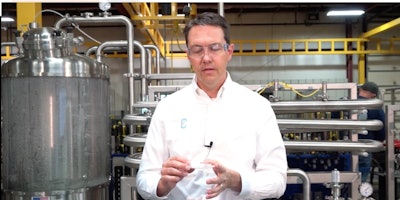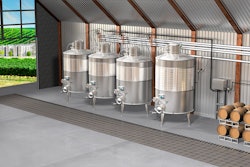If your pump makes popping noises or sounds like gravel is running through it, that may be a sign of pump cavitation. As Eric Gore, technical director at Central States Industrial, explained in a live demo at PACK EXPO Connects, cavitation is in essence the creation and later collapse of bubbles in a fluid.
Beyond the loud noise, pump cavitation can pit the metal components of your pump and damage pump seals, shortening their life span.
As Gore demonstrated in the demo, increasing speed in the line from the tank caused:
- A significant amount of bubbles in the sight glass,
- A loud gravely sound, and
- Low and erratic pressure readings on the pump inlet, with erratic outlet pressure as well.
One of rule of thumb he noted: if it’s hard to have a conversation over the pump noise, there’s a good chance the pump is having problems due to cavitation.
Why do you care if your pump cavitates? As bubbles go into the pump, they collapse very quickly and this is hard on the internal pieces of the pump. Disassembling the pump may reveal that the impeller looks like it’s been sandblasted and pieces of material are missing. It’s also hard on the motor and can shorten bearing life, while pump seals also take a hit with damage and shorter lifespan.
Common fixes
- Often, the issue is that the piping leading into pump is too small or too long (too far away from the source). This is typically a calculation that can be performed, and your pump supplier can help you determine if either of these pipe factors are the issue. You want to calculate how much liquid can freely flow to the pump.
- There are other equipment issues—a strainer on the line could plug and starve the pump. The strainer may be there to protect the pump, but if enough orifices become clogged, then flow will be affected. Valve issues include a valve being inadvertently left in a semi-closed state causing a pressure drop.
- Sometimes the issue is related to the tank. “We hear from folks that in beginning of the batch, it works fine. When the tank is full, there’s enough weight pushing to cause pressure and make it work well,” said Gore. When the level is low toward the end of the tank, there’s not enough pressure and the pump cavitates. In this case, processors can adjust the minimum volume in the tank or alternatively raise the tank higher in the air and add leg extensions to it to fix cavitation problems.
To view the demo in its entirety (available through March 31, 2021), and add CSI to your MyConnects Planner, click here.


























